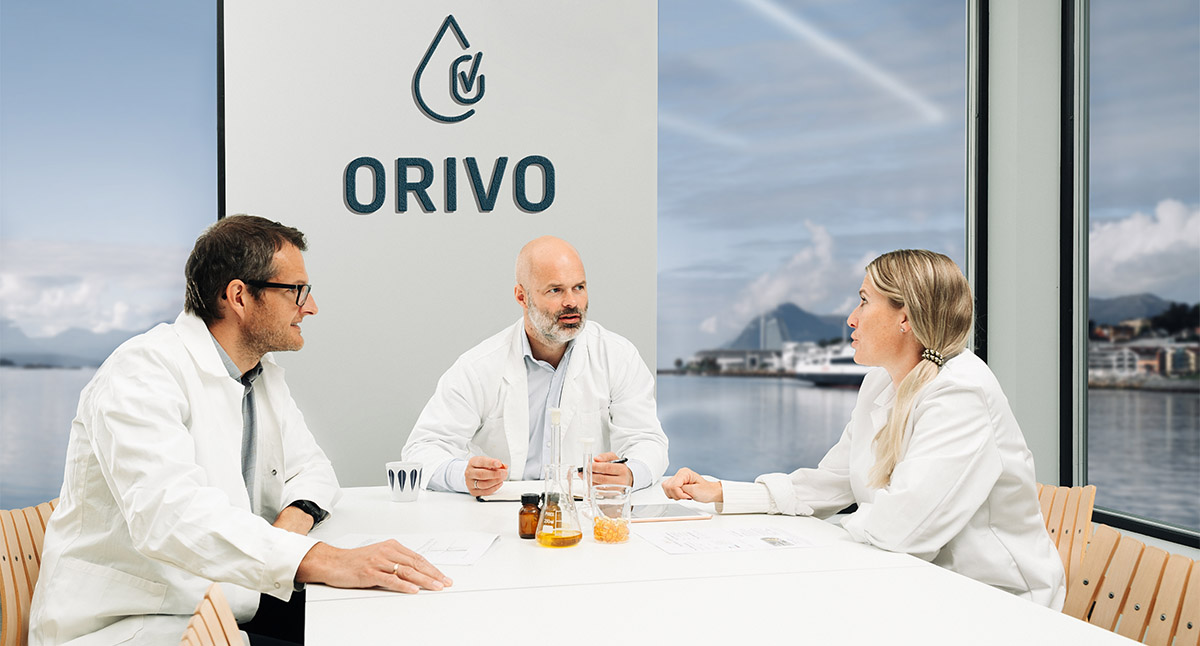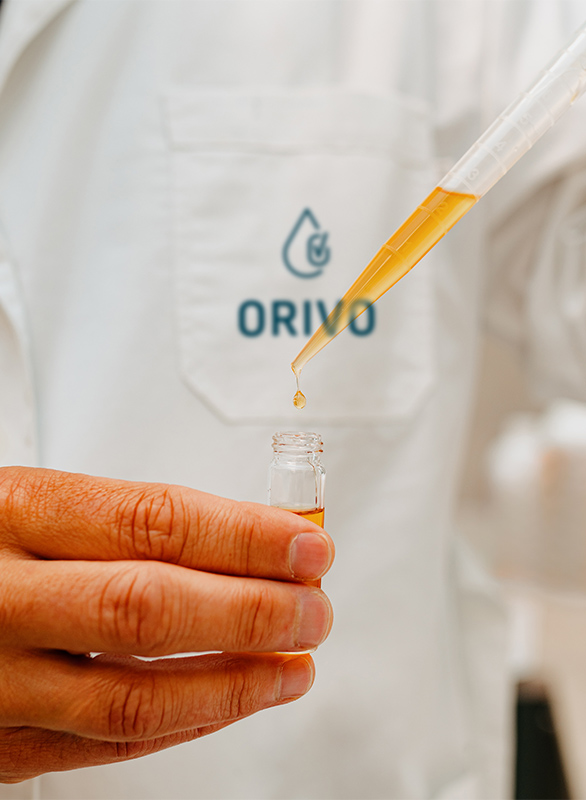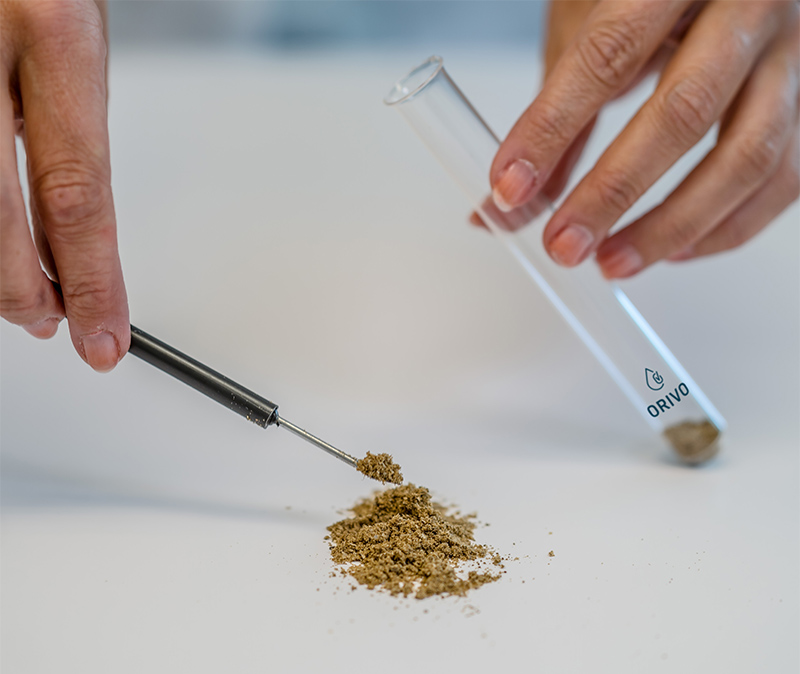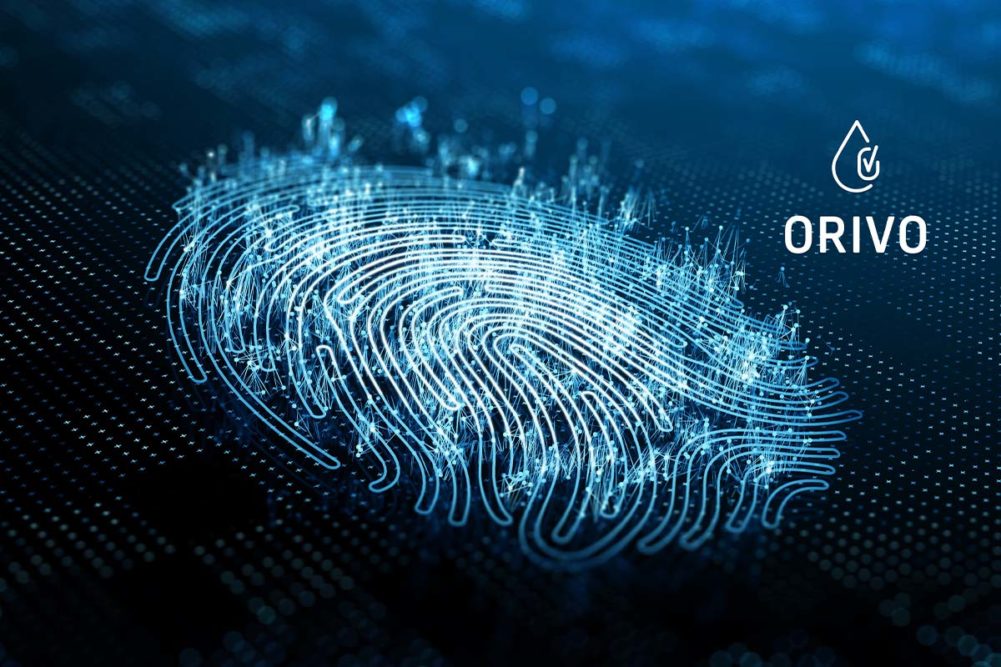MOLDE, NORWAY — According to a recent report from FMI – The Food Industry Association and NIQ (formerly NielsenIQ), 76% of grocery shoppers in the United States today agree that transparency is important, up from 69% of shoppers in 2018. This includes a growing penchant for complete ingredient lists, easily understandable on-pack information, and a brand’s sustainability practices.
As 66% of this population owns at least one pet, these sentiments toward transparency are naturally trickling into their pet product purchasing decisions. With this in mind, two Norwegian chemists established ORIVO with a goal to make origin transparency in the marine ingredient space an industry standard best practice, rather than a luxury, with the main beneficiaries being consumers — both two- and four-legged.
Omega origins
Strategically located in an Omega 3 cluster on the western coast of Norway, Co-Founders Svein Erik Haugmo, chief executive officer, and Erik Fuglseth, Ph.D., chief technology officer, set out in 2014 with what they believed to be a foolproof plan — offering marine origin verification for the many Omega 3 producers throughout the region. However, it wasn’t long before they made an unfortunate revelation.
“We found that these Norwegian Omega 3 producers didn’t use Norwegian raw material — they used raw material from Peru, Morocco or elsewhere, and often in a blend” Haugmo said. “That meant that an origin verification program did not necessarily align well with the way they positioned and marketed their products.”
Herein lies the ugly truth of the global fish oil supply chain. Recent years have seen an influx of interest in fish oil supplements, particularly in the pet nutrition space, but this demand paired with shortages in raw material have created a perfect storm of economically motivated adulteration.
Instead of abandoning ship, Haugmo and Fuglseth decided to pivot in their approach, embed themselves in the industry through conferences and tradeshows, seek funding to further develop their technology, and try again.
Their breakthrough came in Poland, when a local distributor of Omega 3 supplements heard about ORIVO and requested to add the company’s logo to his packaging. After just a couple of months, ORIVO found a way to accommodate his request, and the company had its first consumer-facing label on store shelves.
“That was at least one important turning point in our story,” Haugmo said. “We saw that, in certain markets, there are consumers that really want to have proof for the ingredients used in a finished product.”

From left: Erik Fuglseth, Ph.D., chief technology officer; Svein Erik Haugmo, chief executive officer; and Synnøve Hagen-Hanset, operations and digital marketing manager at ORIVO.
| Source: ORIVOAnother turning point for the business was when Haugmo and Fuglseth realized they had an opportunity to verify marine origin not only for fish oil, but also for fish meal. When a fish is caught and processed, the result is a whole lot more fish meal than fish oil, Fuglseth pointed out. Upon this realization, ORIVO applied for more research funding and expanded its scope to include this new realm of opportunity.
“That quickly opened the market for salmon meal producers, which are important in in the pet food industry, and was super important for us at an early stage to be able to get steady income and use it to grow further,” Fuglseth said.
Rather than broadening its scope within the Omega 3 market to provide verification on quality, heavy metals, pesticides and other unsavory ingredient attributes, Haugmo and Fuglseth made a strategic decision to stay narrow in their origin focus but expand into new market segments that utilize Omega 3 fish oils and other marine-based ingredients, such as food and supplements for people and pets. The company is currently working on ways to verify marine origin for fish fillet for human consumption and is continually exploring new technologies to enhance transparency in the marine ingredient space.
Fingerprinting technology
Haugmo and Fuglseth both bring a background in chemistry to the table. Haugmo has a master’s degree in biochemistry and formerly worked in laboratory and commercial environments to hone molecular biology techniques. Fuglseth specializes in organic chemistry, a field in which he holds a Ph.D. After earning his doctorate, Fuglseth worked in Norway’s Technology Transfer Office, where he helped commercialize university research.
Their combined experience provided a jumping-off point for the launch of ORIVO and, with it, the ability to provide science-based origin evidence to elevate responsible brands, help mindful businesses boost their transparency, and protect consumers from food fraud.
“Most of the technologies we use are platform technologies,” Fuglseth explained. “Basically, that means we can work with a number of applications, but we need to see a need in the market before we actually jump at creating databases and new technology for other market segments.”
The technology that started all this is nuclear magnetic resonance (NMR) spectroscopy, which Fuglseth likened to MRI technology. The NMR spectroscopy method is the result of more than 20 years of research from SINTEF, a reputable Scandinavian research institute. The technology is used on the fat molecules of collected samples to determine origin.
 Source: ORIVO
Source: ORIVOORIVO collects samples from fishing companies, analyzes the samples, and adds them to its databases. This was done manually at first, but today advanced statistical algorithms are used to streamline the process. Additionally, the company swapped outdated computers and software for state-of-the-art machinery in 2018, an upgrade that significantly improved the speed of results and the efficiency of the technology overall.
The technology can be applied to a wide range of products, including cosmetics, wine, coffee, and other consumer goods, but ORIVO remains committed to leveraging it to verify Omega 3 origin.
The ocean is everchanging — even within a single season, the content of fat molecules found within fish species can change depending on a myriad of environmental factors. This necessitates constant database maintenance to ensure ORIVO’s platform technologies can identify and categorize biomarkers and data points with precision and accuracy over time.
“Typically, you see one fatty acid composition in the oil at one stage in the season and another one later in the season, and that’s why regular maintenance of the database is so important,” Fuglseth explained. “Although the changes we see within species are far smaller than the changes between two different species, for instance, we still need to keep the database updated.”
Digging into the DNA
The NMR spectroscopy technology is expanded with each new sample, but Haugmo and Fuglseth soon realized it had limitations when it came to certain fats and protein-based products. In its perpetual exploration of new technologies, ORIVO sought to close this gap through the use of isotopic ratio mass spectroscopy (IRMS) and DNA technology.
“We didn’t want to fall too much in love with our technology,” Haugmo said. “As we expanded the range of products we worked with, we knew NMR would have its limitations. So, instead of trying to compensate for these limitations by building the strongest database with thousands of samples for a specific category, we decided to dig deeper into the molecules and use isotope ratio technology, which proved to be better for certain types of fish ingredients and fish-based products. For protein-based products, DNA technology was an obvious candidate to look into.”
However, current capabilities with DNA technology are only semi-quantitative. Additionally, this technology was developed for use in fresh foods — not products like pet food and feed, which are subjected to high-heat cooking conditions that damage the DNA of their ingredients in the process.
To overcome these obstacles, ORIVO has spent the last two years working on research funded by the Norwegian Research Council and supported by several Norwegian universities, as well as Cornell University in the United States and industry partner BioMar.
“The goal is to be able to come out with a method that enables quantification of the different species in a complex mixture,” Fuglseth explained. “That project will finish soon, and we have very high hopes.”
Haugmo added the successful development of this DNA technology will bring more transparency to the pet food space when it comes to ingredient claims.
 Source: ORIVO
Source: ORIVO“It’s a fantastic opportunity for cheaters in the pet food segment, because they can list salmon as the No. 1 ingredient, but then add a lot of catfish, for example,” Haugmo said. “As long as no one is able to detect the most abundant source, they can do whatever they want — they can list salmon as the first ingredient and chicken as the second, even though the truth is the opposite — because no one can actually detect the difference.”
As ORIVO casts its line further into the fish meal and feed ingredient spaces, the adoption of next generation DNA sequencing into its technological arsenal is expected to bring the company closer to reeling in this big catch.
“There are already pet food brands that want to be very specific and be more scientific on the level of certain ingredients, and for them, and when the technology is more quantifiable, we definitely can bring the evidence in a much greater sense,” Haugmo concluded.
Evidence-based transparency
With this research well underway, in the meantime ORIVO has begun testing the DNA method on mono-protein dry pet food, starting with salmon-based kibble. This allows the company to determine whether a diet includes species other than what’s claimed on the label.
According to Haugmo, the typical adulterants found in salmon-based kibble are chicken and pork proteins. This is particularly concerning for pet owners purchasing salmon-based, hypoallergenic kibbles because of their pets’ sensitivities to other proteins, like chicken and pork. Because hypoallergenic pet foods tend to be priced higher than regular diets, this means pet owners are not only being scammed of what they paid for, but their pets may not be getting the benefit promised on the package.
For example, a market screening by ORIVO involving 35 pet food products purchased off retail shelves in the United States and the European Union showed nearly 60% of the products were not in compliance with ingredients listed on the label. In pet food products that were marketed as salmon-based and free from chicken, ORIVO found substantial amounts of chicken. Among formulas marketed for dogs with food sensitivities, substantial levels of a variety of non-declared species were found.
These results were on par with another market screening conducted by the company, this time involving 15 dog supplements built around the claim “pure wild Alaskan salmon oil.” Of those 15 products, the use of NMR technology revealed more than 80% contained ingredients from other species of fish and regions of the globe.
Misleading consumers in this way is bound to have disastrous impacts on brands that unknowingly — or worse, knowingly — undermine their own transparency. While there is clearly work to be done in this area, third-party players like ORIVO are poised to help mindful brands boost the integrity of their products and build consumer trust, one molecule at a time.
“Consumer data tells us that 80% of North Americans want to know the origin of what they are consuming, and 68% are willing to pay more for a product that can deliver that evidence,” Haugmo said. “That’s a very strong motivation for us — there is money to be made for our clients if they start to act more transparently through evidence, and that’s what we provide.”
Keep up with the latest pet food trends on our Trends page.



